Photos Gracie Malley for Cannabis Now
The Compassionate Path: WAMM’s Next Chapter in California Cannabis
The Wo/Men’s Alliance for Medical Marijuana is fighting for low-income access to cannabis in California’s legal market, and is finding a new home along the way.
It feels wrong to begin this story in the darkness, because today, light is positively radiating on a farm in the Santa Cruz mountains where a legendary California compassionate cannabis collective has found renewed life.
But it is necessary to understand the darkness to see why the Wo/Men’s Alliance for Medical Marijuana farm is so bright today. At a sun-soaked old Boy Scout retreat in the redwoods, WAMM is now cultivating a veritable menagerie of rare landrace strains for its members and planning a future with more regenerative farming practices, new educational programs and personalized cannabis medicine. But at the start of 2018, WAMM’s co-founder was facing a crisis.
A short woman with a magnetic vivacity and dyed red hair to match, Valerie Corral didn’t know if WAMM would have a place that year to grow cannabis for the hundreds of members who depend on the collective’s free cannabis for palliative care.
Corral had recently finalized a divorce from her husband, with whom she’d been growing weed since the 1970s, after she found the plant treated her grand mal seizures. Together, the pair co-founded WAMM in 1993 under the model of distributing free cannabis “to each according to their need” and accepting donations “according to ability.” But in the years-long divorce proceedings, Corral had been forced to sell the couple’s longtime farm outside Santa Cruz, throwing WAMM’s supply chain into disarray. Since 2016, WAMM hadn’t been able to grow on the land, and her worry about the organization’s survival was reaching its peak.

Valerie Corral stands next to the fruits of her labor, in WAMM’s 2018 landrace cannabis garden.
“There are some WAMM members that have been participating in our collective for more than 20 years who rely on our cannabis and I have to keep providing for them,” says Corral. “People spent this year having to trust that everything will work out.”
As Corral spent the winter looking for new ways to provide WAMM’s patients with cannabis, the state of California was busy making her job harder, submerging compassionate cannabis providers beneath a tide of new taxes.
On Jan. 1, 2018, California’s adult-use cannabis regulations kicked in. The regulations required all licensed cannabis providers to pay cultivation taxes and a 15 percent excise tax, regardless of whether or not they were non-profit organizations giving away cannabis for free to severely ill, low-income patients.
“It’s hard to hold our place in the corporate cannabis space,” says Corral. “We’re trying to figure out where our place is in this new industry and how we can gain power.”
In response to the burdensome new taxes, many of California’s compassionate care non-profits — including the Sweetleaf Collective and the Weed for Warriors Project — joined with WAMM under a new organization called the California Compassion Coalition to lobby the state government for tax exemptions. The effort initially proved successful, resulting in a bill called SB 829, which would have eliminated taxes for compassionate care providers. The bill passed both the State Assembly and State Senate with near-unanimous bipartisan support. Then, on the very last day of the 2018 legislative session, in what was one of his last legislative acts in office, Brown vetoed SB 829.

A Malawi landrace strain grows tall in WAMM’s 2018 garden.
“Providing free cannabis to a person with only a doctor’s recommendation undermines these rules [of California’s adult-use cannabis law Prop. 64] and the intent of the voters,” Brown wrote in a statement after the veto.
But medical cannabis advocates argued that Brown was mistaken. For one, the ballot language on California’s Prop. 64 stated it would “exempt medical marijuana from some taxation” (which in practice now is only the sales tax). For another, California citizens had previously supported a regulatory system — under the state’s medical cannabis law Prop. 215, passed in 1996 — that allowed compassionate care collectives to donate medical cannabis tax-free.
In fact, it was these compassionate cannabis providers who served as the vanguard of the legal cannabis movement to begin with. In the 1970s, it was the efforts of advocates like Dennis Peron and Brownie Mary, who distributed cannabis for free to ailing AIDS and cancer patients, that sparked public sympathy and support for medical cannabis users. In the 1990s, WAMM was a major member of this compassionate movement. The fact that these activists were giving cannabis to desperately sick people for free was a crucial piece of the medical marijuana movement’s narrative.
It awarded the activists a moral righteousness, an ability to defend themselves against arguments that they were parasitic drug dealers distributing an evil substance for personal gain.
And the movement’s narrative proved successful, as a wave of states legalized medical marijuana and many of those states — including California, Washington and Oregon — featured regulations that allowed room for compassionate care collectives to thrive. Corral even helped co-author Prop. 215, which ensured access to medical cannabis for low-income medical patients in California.
But as those states have transitioned to adult-use cannabis markets in the years since, state governments have adopted regulations that undermine the viability of compassionate care non-profits.
“We used to drink coffee and foment revolution, but now the movement has been co-opted,” Corral says with a laugh.
While she’s optimistic that SB 829 could be reintroduced this year and could see support from California’s new governor Gavin Newsom, Corral says she’s come to terms with paying taxes to the state. After many years tangling with the government over cannabis policy (including been raided twice, once by local police in 1992 and once by the DEA in 2002), she’s full of quips and one-liners that reveal a hard-earned realism beneath what could be mistaken for a naïve generosity.
“Great wealth is going to protect itself,” she says. “That’s just the fundamentals in a market of greed.”
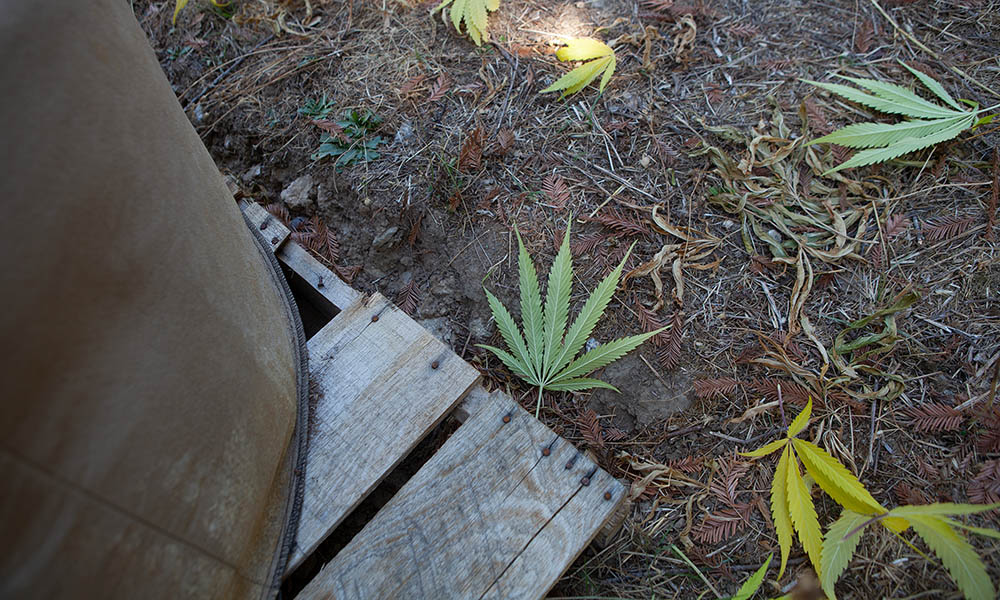
WAMM kept their 2018 plants in smart pots and on pallets, to provide better mobility.
In the midst of all this darkness, the divorce and the taxes, Corral maintained a positive outlook. For example, over the year she spent trying to find a new home for the WAMM farm, Corral believed that WAMM’s generosity would somehow be repaid and that it would survive.
“The lesson I had to learn this last year was to trust in the goodness and the fact that I’d invited people to step up,” she says.
And she was right. First, plenty of different California growers donated cannabis to the collective after hearing about WAMM’s struggles and then, Jeff Nordahl showed up.
A longtime cannabis cultivator who recently started a raw cannabis juice company called Jade Nectar, Nordahl had purchased an old Boy Scout retreat down the road from the former WAMM farm and had a massive collection of obscure cannabis genetics he wanted to grow on the land.
“Jeff appeared and asked me, ‘How can I help?’” Corral says. “What a f*cking beautiful human.”
Landrace Paradise
On a hot October afternoon characteristic of Santa Cruz’s late summers, Corral and Nordahl are preparing to host a celebration harvest dinner on the new farm. They’ve invited me to visit while the garden is at its peak, before the plants are cut down and left to cure. When I arrive, the fruits of their labor are soaking in the sun’s rays and leaking the smell of warm earth and grassy terpenes into the air. An Anatolian shepherd the size of a miniature horse saunters up to me at the gate. She accepts a few pats and runs up the hill to curl up on an empty pot of soil.
Nordahl introduces me to the plants first. He’s arranged the plants in rows in a grassy clearing along the sloping hill below a now-empty Boy Scout lodge. They’re growing in smart pots atop wooden pallets, which Nordahl explains is because he wanted to make sure WAMM could move the plants if they encountered any regulatory speedbumps after moving onto the land.
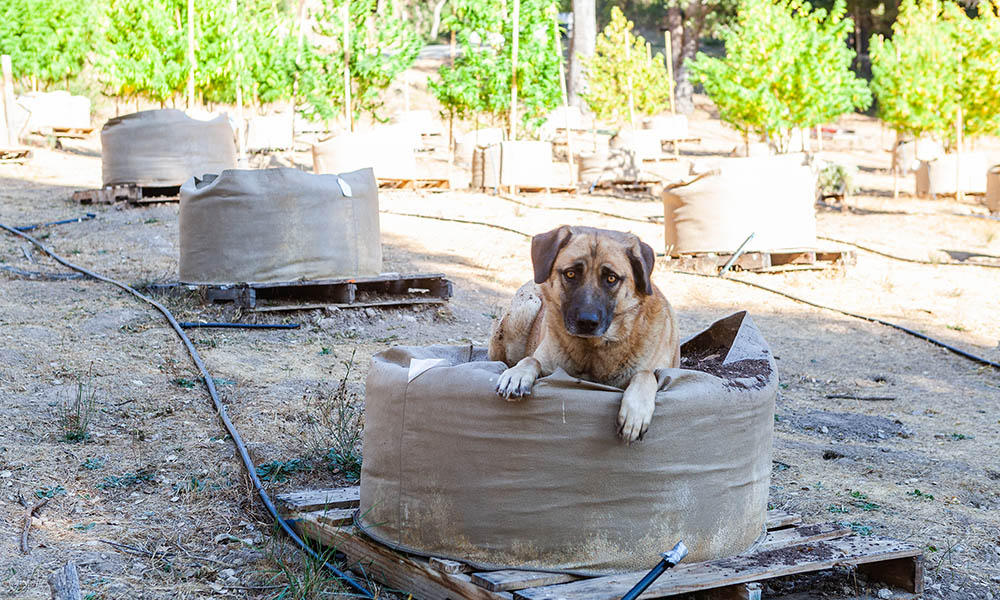
Anna, an Anatolian shepherd, relaxes on the pot of dirt of a just-harvested cannabis plant.
Nordahl has the classic appearance of an OG cannabis farmer, with sun-loved skin, short graying hair pulled back into a tiny ponytail and roughed up cotton clothing. And he talks like an OG, too, with constant devotion in his voice for his garden of re-discovered landrace strains.
“This is a renaissance,” he says. “When I see plants cramped into greenhouses and indoor grows, they look to me like chickens in cages on drip feeds. At this grow, we’re saying, ‘Come on little plants, we’ll set you free!’”
He walks me through the garden, where nearly every pot contains a different strain. There’s an incredibly bushy and colorful Afghan Kush with a pungent diesel smell that sticks out immediately, as well as two tall and scraggly sativas that Nordahl calls “lemur weed” from Madagascar, a landrace smuggled to Santa Cruz from Thailand called Big Sur Holy Weed and a frosty Acapulco Gold. Other heritage strains that stood out in the garden included Pakistani Kush, Natural Mystic, Lamb’s Bread and Panama Red.

WAMM’s Afghan Kush.
“What do you think of paradise?” says Corral, as she joins our tour and gestures around the garden. It certainly does feel different than most other cannabis gardens I’ve visited, almost more akin to a living museum or an art gallery. Almost every plant has a smell or a structure that is new to me, and the plants aren’t heavy with buds, but rather growing tall and straight towards the sun. Most of the plants are self-supported, requiring no trellising, which Nordahl credits to the fact that plants in the garden represent genetic lines that are used to growing in the wild without human help.
“We’re on a cannabinoid hunt with these rare strains,” Nordahl says. And while he’s certainly having fun experimenting with growing exotic strains, there’s also a logical reason the WAMM garden is focusing on growing landrace strains for their patients: “These strains have a way more balanced spectrum of cannabinoids that support the entourage effect and make the strains much more healing,” he says. “This is how cannabis used to be.”
For the 2018 season, Nordahl says he and his team of growers popped 200 phenotypes of over 20 different strains, including mystery seeds and old seeds he’d been saving over the years. Each plant is backed up with cuts and seeds from males they’ve used to create a “mini seed bank.”
Corral says that the WAMM patients are excited about the diversity of strains growing on the garden. She adds that as medicine moves in the direction of more personalized care, there’s going to need to be a wealth of strains with balanced cannabinoid profiles, rather than simply high THC content.
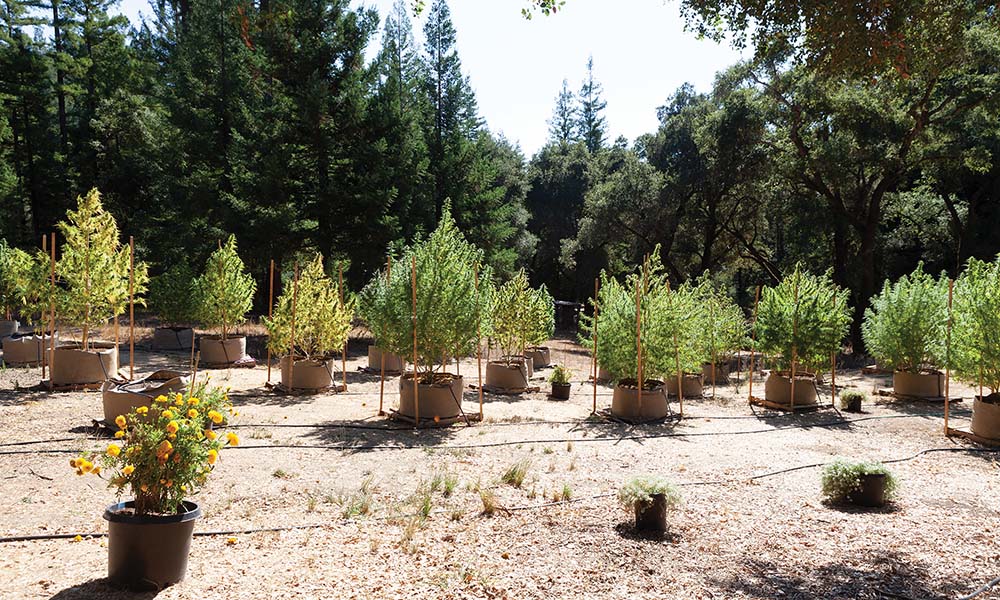
By keeping the plants in smart pots and on pallets, WAMM made sure they could move the plants if authorities kicked them off their new land.
WAMM’s compassionate cannabis business model makes experimental growing projects like this one possible. Nordahl doesn’t have to grow with an eye on consumer trends, he doesn’t have to worry about scaling up, he doesn’t have to worry about squeezing as much THC out of the genetics as he can and he doesn’t have to worry about branding the products, because they’re not going on sale. He only has to worry about growing healthy, clean plants with healing properties.
“When we smoked the Colombian Gold we harvested early, we all looked at each other and said, ‘Oh, that’s what cannabis is supposed to taste like,’” says Nordahl. “It’s like the time I tasted a wild heritage turkey and realized how much more incredible it was than a store-bought turkey.”
Because Nordahl and Corral moved on the old Boy Scout land in the middle of the 2018 growing season and had to keep the plants in smart pots on moveable pallets, Nordahl says they haven’t been able to start building the fully regenerative growing system that he’s dreaming of. This year, the plants were grown with entirely organic practices, with help from local horse manure, alfalfa and earthworms, but Nordahl has a vision to take it further.
“We’re going to have living soil, raised beds, a closed nutrient loop and medicinal companion plants growing next to the cannabis,” he says.
But this future is a few months away. For now, there’s a harvest party to host in just a few days. The current plan is that Nordahl, Corral and their friends are going to feast near the garden on picnic tables that are painted, like the rest of the buildings on the property, a color that Nordahl says is officially known as “state park brown.”
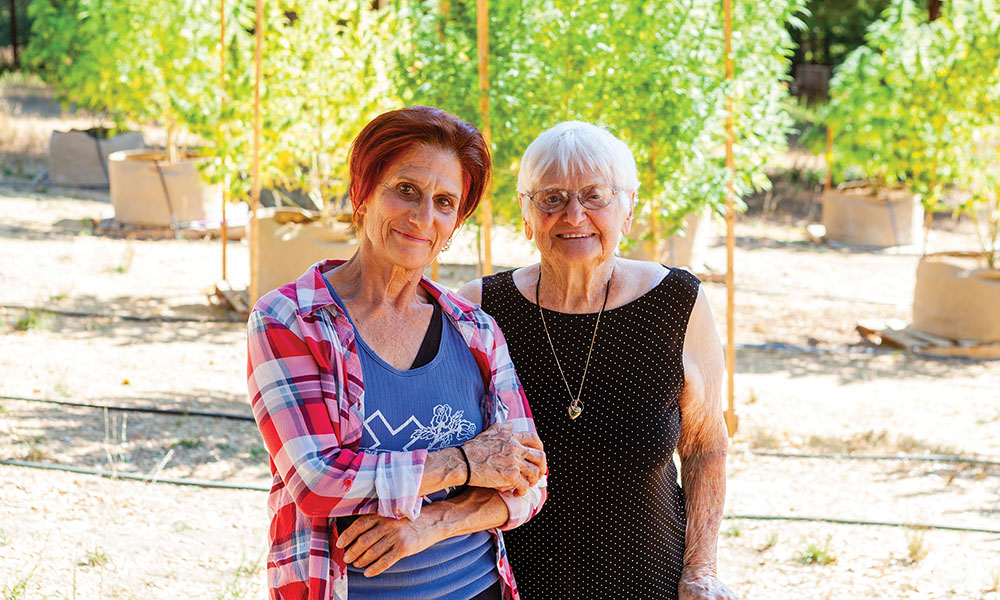
Valerie Corral, co-founder of WAMM, and her mother, best known as Nonna Marijuana, stand in WAMM’s new landrace garden.
As the afternoon heat begins to wane, we finish touring the garden and sit down to eat a late lunch on the state park brown picnic tables together, joined by Corral’s 96-year-old mother Aurora Leveroni, better known as the edibles-cookin’ YouTube personality Nonna Marijuana. Over avocado and salami sandwiches, Nonna tells us stories about growing up in San Francisco, about how Corral’s ancestors came to California in a covered wagon in the 1860s. She talks of living in a house in North Beach with chickens and a backyard garden that faced Alcatraz, of surviving the Great Depression by sharing what they had with their neighbors. As Nonna tells her story, Corral breaks off pieces of cheddar cheese as offerings for the bees circling around our lunch. She says, “We have plenty to spare.”
The Future of Cannabis Compassion
Nordahl isn’t just planning on building a regenerative garden for WAMM, he also has plans for how WAMM can fully embrace the 250 acres of old Boy Scout retreat land he now owns. With the empty Boy Scout lodge up the hill, Nordahl says he is thinking about turning it into a space that could host retreats and he’s thinking about building a swimming hole or pool on the land that could double as an emergency water supply.
From the deck on the Boy Scout lodge, the view of the land is breathtaking. There’s no sign of other human settlement, except a few power lines overhead and the distant rumble of construction up the canyon. There are only ridges of redwood trees as far as the eye can see, and ripe cannabis swaying softly in its clearing amid a few old oak trees. The grass on the ground is brittle and dry, a California indicator that it is time to harvest the year’s efforts. And this year has been filled with change. This old land, long left unused, has produced a new crop. The old buildings have turned into a new home, for new inhabitants finding their way after old rules gave way beneath new laws.
Today, WAMM is still in transition, still figuring out its place in California’s new legal system. Corral says that WAMM has just finalized renting a building in downtown Santa Cruz, where they’ll be able to offer cannabis education courses, host fun events like comedy shows, and have a doctor and a chemist volunteering there.
“It’s going to pay for itself,” she says. “We’ve never been rich, but I’ve never needed to be rich.”
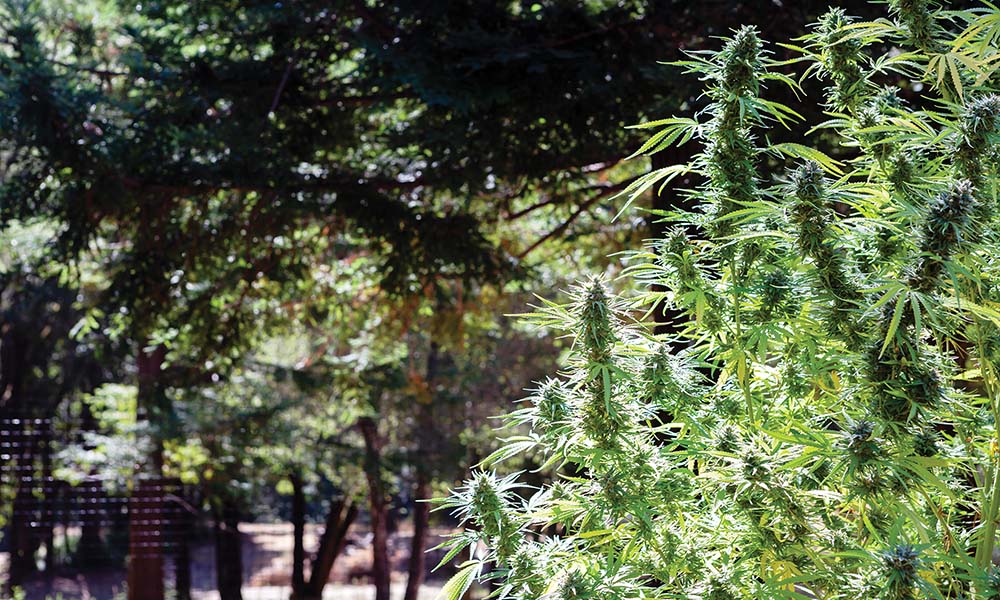
WAMM’s landrace garden, filled with unique phenotypes, allows the collective to help patients with a variety of diseases.
And WAMM is planning on continuing to lobby for tax exemptions for compassionate care providers, especially in the hopes that Gov. Newsom will be different from his predecessor.
“It’s not that I think Governor Brown is a bad person, it’s that I think he has no conception of the pain he’ll cause when he doesn’t sign a bill into law,” Corral says. “I’ve been at the bedside of more than 200 people as they are dying, and you know, that has provided me the opportunity to shift away from narrowmindedness. I think Gavin Newsom has some compassion, so I want to get to him and try and shift his consciousness.”
If Corral is successful in working with other compassionate care providers to change the tax structure in California, she might succeed in changing not just Gov. Newsom’s mind, but she’d also help codify into law that there must be support for low-income medical cannabis patients in legal cannabis markets, that people should not have to pay for medicine they need but cannot afford.
But for now, as the sun bends behind the redwood ridge, she’s thinking about how to make room on the farm for all the guests’ cars who will be arriving for the harvest party and helping her mother feed the bees.
TELL US, how do you think California’s laws should treat compassionate care providers?
Originally published in Issue 35 of Cannabis Now. LEARN MORE



















